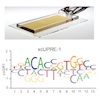 Basic leucine zipper transcription factor Hac1 binds DNA in two distinct modes as revealed by microfluidic analyses
Basic leucine zipper transcription factor Hac1 binds DNA in two distinct modes as revealed by microfluidic analysesPolly M. Fordyce, David Pincus, Philipp Kimmig, Christopher S. Nelson, Hana El-Samad, Peter Walter, and Joseph L. DeRisi
PNAS 2012Abstract: A quantitative understanding of how transcription factors interact with genomic target sites is crucial for reconstructing transcriptional networks in vivo. Here, we use Hac1, a well-characterized basic leucine zipper (bZIP) transcription factor involved in the unfolded protein response (UPR) as a model to investigate interactions between bZIP transcription factors and their target sites. During the UPR, the accumulation of unfolded proteins leads to unconventional splicing and subsequent translation of HAC1 mRNA, followed by transcription of UPR target genes. Initial candidatebased approaches identified a canonical cis-acting unfolded protein response element (UPRE-1) within target gene promoters; however, subsequent studies identified a large set of Hac1 target genes lacking this UPRE-1 and containing a different motif (UPRE-2). Using a combination of unbiased and directed microfluidic DNA
binding assays, we established that Hac1 binds in two distinct modes: (i) to short (6–7 bp) UPRE-2-like motifs and (ii) to significantly longer (11–13 bp) extended UPRE-1-like motifs. Using a genetic screen, we demonstrate that a region of extended homology N-terminal to the basic DNA binding domain is required for this dual site recognition. These results establish Hac1 as the first bZIP transcription factor known to adopt more than one binding mode and unify previously conflicting and discrepant observations of Hac1 function into a cohesive model of UPR target gene activation. Our results also suggest that even structurally simple transcription factors can recognize multiple divergent target sites of very different lengths, potentially enriching their downstream target repertoire.
